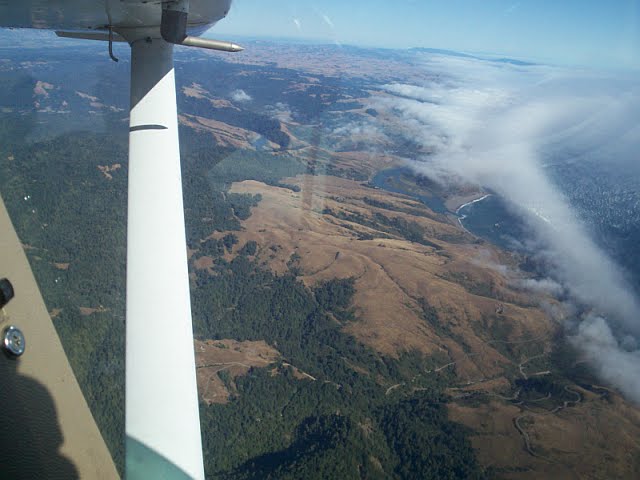So what if I’m a little too long in the flare? Who cares if I drop in from five feet as long as I’m on the mains? What’s a little bounce if no one is there to notice?
Why the hell should I stress over whether the tires make that perfect little chirp every time I land?
I honestly think this has been my mindset for some time now.
A recent flight with my wife, Linda, has made me reconsider my attitude about landing. She told me that my landings make her uncomfortable.
This surprised and concerned me. The last thing I want to do is make my best friend and co-pilot uncomfortable in the airplane.
I spent a little time re-living my most recent attempts at returning 34777 to earth. I had to admit she’s right – my landings are simply not good enough and not just for her sake. They are not good enough for me, either. I realized I have not been happy with them but didn’t want to face the fact until she brought it up.
Here I am in the middle of my IFR training and I need to go back to square one and try and learn the fundamentals of a good landing. This seems wrong somehow. I’m pretty sure smart people don’t have my problems.
I learned to land via the “power off abeam the numbers” technique. I rarely landed fast, but my approaches could not be considered stabilized. The technique is now out of vogue with the FAA, though it is good to practice for engine out emergencies.
The Fundamentals of a Stabilized, Partial Power Landing
The most important concept for stabilized approaches and good landings is to fly the entire approach at the proper airspeed (Cessna Cardinal, Vso = 57 mph):
· Downwind Vso x 1.5= 85 mph
· Base Vso x 1.4= 80 mph
· Final Vso x 1.3= 75 mph (at max. gross 15% flaps) ; 70 mph (2300# ; 15% flaps)
Learn the power setting that provides the initial airspeed and attitude. (12” manifold pressure? Check!)
As you enter the downwind, review the pre-landing checklist:
· Verify the runway you are landing on
· Runway length?
· Wind direction and speed?
· Fuel tank on both; Mixture rich; Prop forward; carb. heat full on; engine instruments; radio frequency confirmed
· Parallel distance from runway, approx. 45° down
If you fly the approach too fast the following may occur:
· The pattern will be larger than necessary
· It will be difficult to stabilize the approach and it will be harder to fly properly
· You will need to make steeper turns
· It will take longer to get the plane into a nose-up flare attitude
· Raises the risk of “dropping in”
· Runs the risk of ballooning
Abeam the Numbers
Verify the runway number!
Review runway length AND width. Narrow runways can cause too low an approach. Wide runways may cause too high an approach. Short runways deserve extra consideration - go around if things aren't perfect!
Reduce power, add a notch of flaps and trim for 85 mph. This should result in a 300 – 400 FPM descent rate.
Note the sight picture over the nose and the angle of the wings to the horizon.
As you make the turn to base do not let the nose drop. Use a little backpressure. Letting the nose drop will increase airspeed, which we do not want in a stabilized approach. There is a tendency to drop the nose to subconsciously avoid the stall/spin scenario. This should not be an issue if the nose is already pitched down and the airspeed is correct.
Turning Base
Add the second notch of flaps; pitch nose down and trim for 80 mph.
Check final approach for traffic.
Review height above touchdown aiming point and make slight adjustments.
On Final
Add full flaps, pitch nose down and re-trim for 70 mph.
Make little corrections early – so slight that your passengers do not notice.
If too low, bring power up and nose up. DO NOT RE-TRIM. Once you are back on the glide path the plane will return to the pre-set trim speed.
If too high, bring power back and pitch down. DO NOT RE-TRIM.
At an altitude of 20 to 30 feet, pull off the power completely.
As you get near the runway look overt the left side of the cowling and 100 to 200 feet ahead. Don’t fixate, keep your scan moving. Do not look straight down. The blurring effect may be interpreted by your brain as being the correct time to flare when, in fact, you are still too high.
Ensure the plane is not drifting to one side or the other that would impose side loads on the landing gear.
As you round out the flare pitch the nose up into a climb (or slow flight) attitude and hold off the runway. The increased drag from the nose-up pitch will cause the plane to descend gently to the runway.
Finally, leave the flaps down until exiting the runway. This is a good habit to establish for a future transition to a retractable gear airplane.
Well it sounds simple, doesn’t it?
Gary



No comments:
Post a Comment